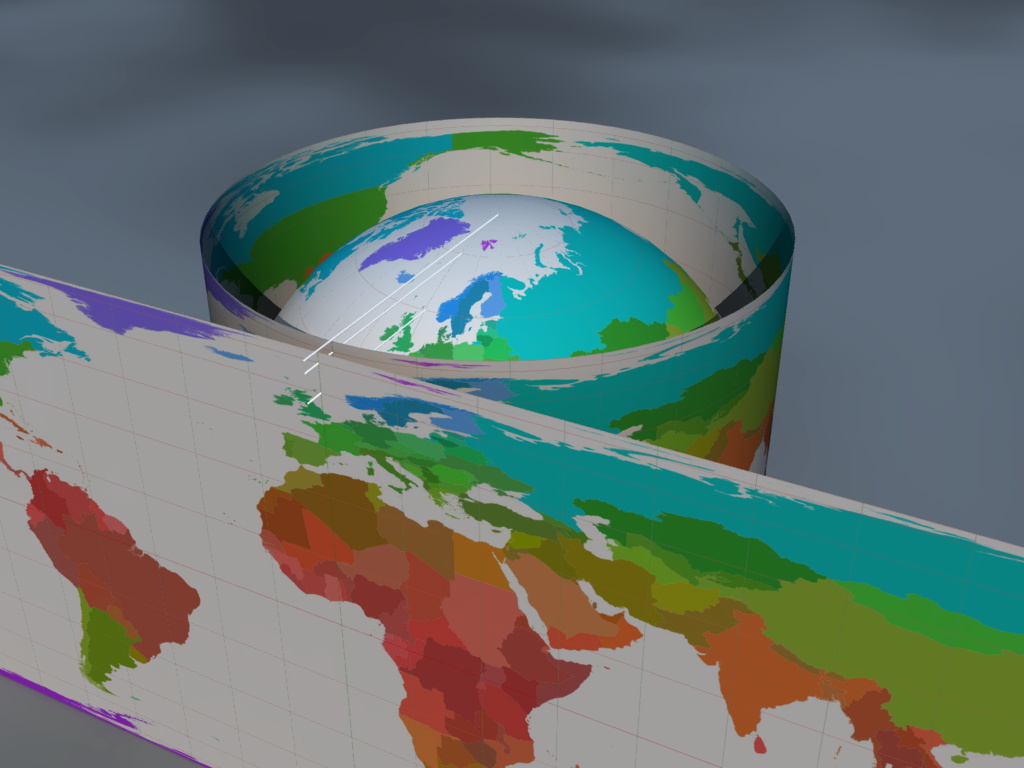Lambert cylindrical equal-area projection on:
[Wikipedia]
[Google]
[Amazon]


 In
In
 The projection was invented by the Swiss mathematician
The projection was invented by the Swiss mathematician
Table of examples and properties of all common projections
from radicalcartography.net {{DEFAULTSORT:Lambert Cylindrical Equal-Area Projection Map projections Equal-area projections

cartography
Cartography (; from grc, χάρτης , "papyrus, sheet of paper, map"; and , "write") is the study and practice of making and using maps. Combining science, aesthetics and technique, cartography builds on the premise that reality (or an i ...
, the Lambert cylindrical equal-area projection, or Lambert cylindrical projection, is a
cylindrical equal-area projection. This projection is undistorted along the equator, which is its standard parallel, but distortion increases rapidly towards the poles. Like any cylindrical projection, it stretches parallels increasingly away from the equator. The poles accrue infinite distortion, becoming lines instead of points.
History
 The projection was invented by the Swiss mathematician
The projection was invented by the Swiss mathematician Johann Heinrich Lambert
Johann Heinrich Lambert (, ''Jean-Henri Lambert'' in French; 26 or 28 August 1728 – 25 September 1777) was a polymath from the Republic of Mulhouse, generally referred to as either Swiss or French, who made important contributions to the subject ...
and described in his 1772 treatise, ''Beiträge zum Gebrauche der Mathematik und deren Anwendung'', part III, section 6: ''Anmerkungen und Zusätze zur Entwerfung der Land- und Himmelscharten'', translated as, ''Notes and Comments on the Composition of Terrestrial and Celestial Maps''.
Lambert's projection is the basis for the cylindrical equal-area projection family. Lambert chose the equator as the parallel of no distortion. By multiplying the projection's height by some factor and dividing the width by the same factor, the regions of no distortion can be moved to any desired pair of parallels north and south of the equator. These variations, particularly the Gall–Peters projection, are more commonly encountered in maps than Lambert’s original projection due to their lower distortion overall.
Formulae
: where ''φ'' is thelatitude
In geography, latitude is a coordinate that specifies the north– south position of a point on the surface of the Earth or another celestial body. Latitude is given as an angle that ranges from –90° at the south pole to 90° at the north pol ...
, ''λ'' is the longitude
Longitude (, ) is a geographic coordinate that specifies the east– west position of a point on the surface of the Earth, or another celestial body. It is an angular measurement, usually expressed in degrees and denoted by the Greek lette ...
and ''λ'' is the central meridian.
See also
* List of map projections *Lambert azimuthal equal-area projection
The Lambert azimuthal equal-area projection is a particular mapping from a sphere to a disk. It accurately represents area in all regions of the sphere, but it does not accurately represent angles. It is named for the Swiss mathematician Johann ...
* Lambert conformal conic projection
References
External links
*Table of examples and properties of all common projections
from radicalcartography.net {{DEFAULTSORT:Lambert Cylindrical Equal-Area Projection Map projections Equal-area projections